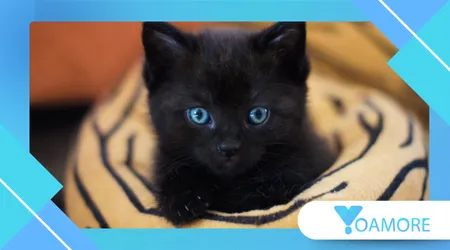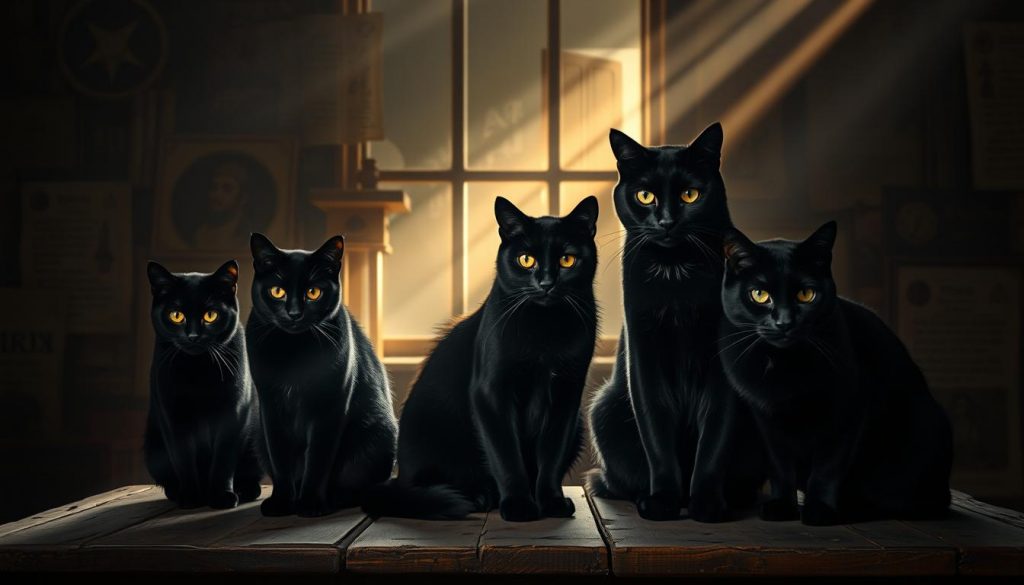Por que os gatos pretos são temidos (e amados) em diferentes culturas

Aqui está um choque de realidade: estudos em abrigos nos EUA relatam que gatos pretos enfrentam uma taxa de eutanásia de 74,6% e uma taxa de adoção de apenas 10%.
Anúncios
Essa lacuna gritante mostra como superstições sobre gatos pretos ainda moldam vidas reais. O mito da má sorte permanece, mesmo que outras culturas vejam uma boa sorte gato preto como um sinal de fortuna ou amor.
A história oferece uma tela dividida. No Egito Antigo, gatos com pelos escuros eram amarrados a Bastet, a deusa do lar e da saúde.
Matar um gato pode levar à pena de morte. No mar, os marinheiros europeus valorizavam Gatos pretos para viagens seguras.
Na Escócia, um gato preto na porta significava prosperidade. No Japão e no Reino Unido, eles costumam ser vistos como amuletos e não como maldições.
Anúncios
No entanto, o história dos gatos pretos também se torna sombrio. Durante a Idade Média, bruxaria e gatos pretos fundiu-se em sermões e no folclore popular. O medo se espalhou pela Europa e chegou à América colonial.
Daí surgiu a imagem familiar do Halloween e o velho aviso sobre um gato cruzando o caminho.
Esta seção mapeia como crenças culturais sobre gatos pretos divergem — e por que essas crenças ainda afetam taxas de adoção de abrigos hoje. Ela prepara o cenário para o vai e vem entre a reverência e a desconfiança, de símbolos sagrados a ícones da cultura pop.
Origens do medo e do favor: da reverência antiga à bruxaria medieval
No Vale do Nilo, Egito Antigo, adoração de gatos elevou os felinos de companheiros domésticos a guardiões sagrados.
Templos homenageados Bastet e gatos pretos como símbolos de calor, proteção e cura. Machucar um gato acarretava penalidades legais, provando o quão profundamente esse respeito estava presente na vida cotidiana e na lei.
Através do Mediterrâneo, os gregos ligados Hécate e os gatos para a noite, encruzilhadas e magia.
Este vínculo inicial entre o divino e o felino motivou leituras posteriores de Gatos do folclore europeu, onde o mistério encontrava o ritual e a crença moldava o comportamento em casa e na rua.
Além dos templos, os marinheiros valorizavam gatos pretos para uma passagem segura e ventos constantes. Dos portos escoceses às aldeias galesas, a chegada de visitantes elegantes e de pelagem escura era um sinal de prosperidade.
Essas histórias acompanhavam conversas sobre familiares, uma palavra que mais tarde definiria como alguns viam os gatos como ajudantes na magia.
A viragem medieval tornou-se acentuada. Em 13 de junho de 1233, o decreto conhecido como Vox em Rama gatos pretos projeta uma longa sombra ao vincular formas felinas ao demoníaco.
O que começou como piedade endureceu em superstição da Idade Média, e histórias de gatos pretos de bruxaria medieval espalhados por púlpitos, pátios e praças.
A violência ritual se repetiu em algumas partes da Europa. Na França, fogueiras eram feitas com gatos pretos para expurgar o mal. Na Bélgica, a tradição de Kattenstoet consistia em atirar gatos de campanários antes de migrar para efígies simbólicas.
Na Dinamarca, os ritos da Quaresma repelem o inverno com golpes, um eco sombrio do alcance do medo.
Tais atos tiveram um custo. Com menos gatos rondando becos e celeiros, os roedores aumentaram. O desequilíbrio agravou a miséria à medida que as doenças se espalhavam, enquanto a culpa ainda recaía sobre os próprios animais.
Gatos do folclore europeu, antes companheiros de viagem sortudos e amuletos para lareira, agora carregavam suspeitas.
Leia também: Seke: O dialeto tibetano esquecido do Nepal
Do outro lado do Atlântico, a memória puritana manteve o padrão vivo. Nas cidades da Nova Inglaterra, sussurros associavam arranhões noturnos e sombras em movimento a ritos ocultos e metamorfose.
A ideia de familiares cresceu, e a imagem de um gato preto no calcanhar de uma bruxa criou raízes em sermões e leis.
Mas as correntes mais antigas não desapareceram. Bastet e gatos pretos ainda representava abrigo e saúde nas releituras da devoção egípcia.
No mar, a sorte se apegava ao gato do navio. Os costumes da Escócia e do País de Gales preservaram uma visão mais suave, mostrando como o contexto transforma a mesma criatura em presságio ou aliado.
| Tradição | Associação Central | Símbolo típico | Atitude Resultante |
|---|---|---|---|
| Egito Antigo | adoração de gatos no antigo Egito e proteção doméstica | Bastet e gatos pretos | Reverência e salvaguarda legal |
| Grécia Clássica | Hécate e os gatos ligado à magia e às encruzilhadas | Guardião liminar | Respeito misturado com admiração |
| Europa Medieval | Vox em Rama gatos pretos e superstição da Idade Média | Imagens e ritos do diabo | Medo, perseguição, queimadas |
| Europa Marítima | Gatos do folclore europeu como protetores de viagem | Gato preto do navio | Boa sorte e viagem segura |
| Crenças de bruxaria | gatos pretos de bruxaria medieval como familiares | Companheiro da bruxa | Suspeita e ação legal |
Gatos pretos em diferentes culturas: boa sorte, má sorte e impactos no mundo real
Através do tempo e do lugar, culturas de boa sorte do gato preto sentar ao lado dos medos que persistem na vida diária.
No Antigo Egito, o casaco elegante evocava Bastet, um sinal de estima e proteção. Marinheiros na Europa mantinham gatos pretos a bordo para garantir a segurança na viagem, enquanto na Inglaterra, presentear uma noiva com um deles era um presságio de um casamento feliz.
No Japão, o folclore associa avistamentos à riqueza e Amor por gatos pretos japoneses, aumentando as perspectivas de romance.
Uma visita à porta sinaliza uma Gato preto da prosperidade escocesa momento, com a fortuna no horizonte. Há muito tempo, na França, diz-se que uma aparição repentina indica algo mágico por vir.
Sonhos com um felino amigável, um gato preto caminhando em sua direção ou um pelo branco solto em um pelo escuro são considerados como sorte em diversas regiões.
Essas tradições ajudam a explicar por que muitos ainda valorizam as silhuetas que passam pelos becos e varandas ao anoitecer.
Outras visões lançam uma longa sombra. Na América do Norte, alguns dizem que a má sorte acontece quando um gato preto cruza seu caminho.
O Estereótipo do gato preto no Halloween e as histórias de Salem alimentam o tabu do cruzamento de caminhos, ecoado por momentos da cultura pop, de Sabrina, a Aprendiz de Feiticeira ao incidente do Chicago Cubs em 1969.
A ciência oferece um contraponto constante. A cor da pelagem não determina o comportamento ou o destino; o preto é uma coloração dominante comum.
O Raça de gato Bombaim, preto como azeviche até a raiz e com olhos expressivos, é conhecido por sua sociabilidade, brincadeira e charme falante — características que desafiam tradições sinistras.
Os abrigos relatam efeitos no mundo real. Os dados mostram abrigo eutanásia gatos pretos as taxas podem ser altas, com preconceito de adoção de gatos pretos ligado à superstição, iluminação fraca e casacos difíceis de fotografar.
Alguns membros da equipe observam problemas de percepção em vez de lacunas uniformes na adoção, mas a experiência de muitos gatos ainda reflete esses obstáculos.
Medidas práticas ajudam. Adotantes que planejam um compromisso de 15 a 20 anos, cuidados veterinários de rotina e enriquecimento mudam os resultados.
Para aqueles que não adotam, doações de alto impacto — produtos de limpeza, areia e caixas, caixas de transporte, toalhas, brinquedos e fundos para compras direcionadas — proporcionam melhor visibilidade e cuidado.
As histórias continuam a evoluir à medida que os donos compartilham a vida diária com afetuosas panteras domésticas, suavizando os velhos limites entre charme e maldição.
+ O papel da superstição na medicina antiga
Se um gato preto cruza seu caminho em uma manhã ensolarada ou se aconchega aos pés da cama, o momento reflete uma história humana mais ampla sobre sorte, medo e o desejo de pertencer.

Conclusão
A história dos gatos pretos é um mapa da crença humana. No antigo Egito, a deusa Bastet simbolizava cuidado e segurança.
Marinheiros por toda a Europa valorizavam o gato-rato de pelo escuro de um navio para dar sorte no mar. Na Escócia e em partes da França, um gato preto cruzando a porta significava prosperidade.
No entanto, éditos medievais como “Vox in Rama” e o folclore de bruxaria lançavam uma longa sombra, alimentando o medo e prejudicando a saúde pública quando o controle de roedores falhava.
Esse contraste define história cultural do gato preto e ainda formas estereótipos de gatos pretos hoje.
Pesquisas modernas mostram que a cor da pelagem não influencia o comportamento, o risco de doenças ou o destino.
Desmascarando mitos sobre gatos pretos está alinhado com o que veterinários e especialistas em comportamento relatam: o temperamento vem da socialização e do cuidado.
A cultura pop ainda se apoia em cenas assustadoras, especialmente com Gatos pretos de Halloween, mas as mídias sociais e o cinema estão os reformulando como companheiros afetuosos e elegantes.
Celebrando gato preto boa sorte tradições do Japão, Reino Unido, Escócia e Europa marítima ajudam a redefinir a narrativa com evidências e empatia.
As realidades dos abrigos persistem. Dados de abrigos nos EUA mostram que preconceitos e até mesmo desafios fotográficos podem reduzir as chances de adoção.
Focado defesa de abrigos pode fechar essa lacuna. Quando as pessoas adote gatos pretos com um plano de cuidado e enriquecimento, eles enfraquecem velhos mitos e salvam vidas.
Destacar raças amigáveis às pessoas, como o Bombaim, e usar fotos brilhantes e bem iluminadas, além de biografias claras, pode levar adotantes hesitantes da dúvida à ação.
O caminho a seguir é prático e humano. Compartilhe histórias precisas. Apoie campanhas durante todo o ano, não apenas em outubro.
Doe suprimentos que atendam às regras nutricionais do abrigo e seja voluntário em programas de fotografia e acolhimento.
Quando as comunidades desmistificam os mitos do gato preto e promovem histórias justas, elas transformam a superstição em gentileza.
Ao fazer isso, eles ajudam adote gatos pretos a taxas mais altas e se aposentar estereótipos de gatos pretos para o passado — onde eles pertencem.
